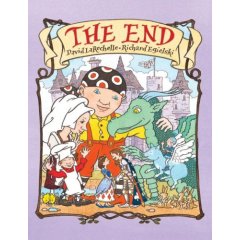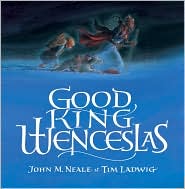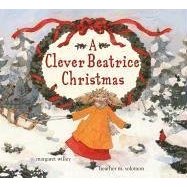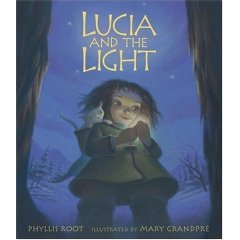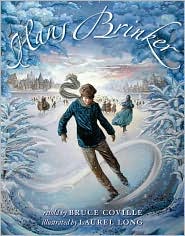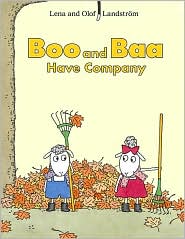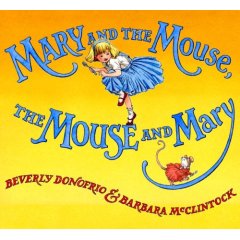Tricia at The Miss Rumphius Effect came up with a list of some her favorite gift books for the December Carnival of Children's Literature (to be hosted by Big A little a). She organized them by category: snow, origami, puzzles and mysteries, nonfiction, and dogs; and wrote a nice precis of each one. She also asked for readers' favorites in those categories; here are some of mine:
Snow
 Grandmother Winter by Phyllis Root; pictures by Beth Krommes (Houghton Mifflin, 1999). What happens when Grandmother Winter shakes her feather quilt? Why, it snows, of course: big soft feathery flakes; then all sorts of creatures (and children!) must make ready for the cold winter. I love Phyllis Root's work; here, she was inspired by the German tales of Mother Holle. And Beth Krommes's scratchboard-and-watercolor illustrations (this was her first picture book; she went on to illustrate Joyce Sidman's award-winning poetry collections) are both beautiful and true.
Grandmother Winter by Phyllis Root; pictures by Beth Krommes (Houghton Mifflin, 1999). What happens when Grandmother Winter shakes her feather quilt? Why, it snows, of course: big soft feathery flakes; then all sorts of creatures (and children!) must make ready for the cold winter. I love Phyllis Root's work; here, she was inspired by the German tales of Mother Holle. And Beth Krommes's scratchboard-and-watercolor illustrations (this was her first picture book; she went on to illustrate Joyce Sidman's award-winning poetry collections) are both beautiful and true.
Origami
 Yoko's Paper Cranes by Rosemary Wells (Hyperion, 2001). Spare text and beautiful art (using origami and washi papers, gold leaf, rubber stamps, and paint) combine to tell a many-layered, extremely satisfying story. Yoko moves to California, but comes up with a symbolic birthday gift to send her grandmother in Japan. Includes diagrams for folding an origami paper crane (not the easiest thing to fold, but perhaps the most well-known). This is also a good wintertime and holiday read, especially for children who live far from their grandparents.
Yoko's Paper Cranes by Rosemary Wells (Hyperion, 2001). Spare text and beautiful art (using origami and washi papers, gold leaf, rubber stamps, and paint) combine to tell a many-layered, extremely satisfying story. Yoko moves to California, but comes up with a symbolic birthday gift to send her grandmother in Japan. Includes diagrams for folding an origami paper crane (not the easiest thing to fold, but perhaps the most well-known). This is also a good wintertime and holiday read, especially for children who live far from their grandparents.
Puzzles and mysteries
The Westing Game by Ellen Rankin (it won the Newbery Medal in 1979). I still remember reading The Westing Game for the first time; it was so unlike any book I had read before (or since). The granddaddy of the puzzle/mystery mid-grade novel. Check out this website, The Westing Heirs; it was created by a group of fourth-graders (and their teachers). So kids are still reading it!
Nonfiction and Dogs
 Dogs and Cats by Steve Jenkins (Houghton Mifflin, 2007). Milly loves dogs; we have a basket full of her favorite "dog books." The usual suspects are in there: Spot, Biscuit, Harry, McDuff; as well as a random assortment of others and a revolving door of dog library books. This fall we added nonfiction, mostly because Steve Jenkins's cut and torn paper collage illustrations are so appealing (ahem, to me), but his text is nicely organized around questions and comparisons. It's fair to say that the "and Cats" part of this two-sided book rarely gets read at our house, though.
Dogs and Cats by Steve Jenkins (Houghton Mifflin, 2007). Milly loves dogs; we have a basket full of her favorite "dog books." The usual suspects are in there: Spot, Biscuit, Harry, McDuff; as well as a random assortment of others and a revolving door of dog library books. This fall we added nonfiction, mostly because Steve Jenkins's cut and torn paper collage illustrations are so appealing (ahem, to me), but his text is nicely organized around questions and comparisons. It's fair to say that the "and Cats" part of this two-sided book rarely gets read at our house, though.
Thanks again, Tricia! Everyone (two? three?) else, please feel free to list or link to your favorites in these categories in the comments as well.
 There are not many picture books that tell about this tradition. One very beautiful one that does is Federico and the Magi's Gift, a Latin American Christmas story by Argentine author and illustrator Beatriz Vidal (Knopf, 2004). The story itself is sweetly simple: Federico is worried that the three kings won't leave him any gifts. Vidal's exquisite watercolor and gouache illustrations (painted using a magnifying glass and very, very small brushes) are anything but. They're magical. I also love the tropical setting: a nice contrast to all those wintry Christmas books. And not to worry, the Magi leave the coveted toy horse for Federico.
There are not many picture books that tell about this tradition. One very beautiful one that does is Federico and the Magi's Gift, a Latin American Christmas story by Argentine author and illustrator Beatriz Vidal (Knopf, 2004). The story itself is sweetly simple: Federico is worried that the three kings won't leave him any gifts. Vidal's exquisite watercolor and gouache illustrations (painted using a magnifying glass and very, very small brushes) are anything but. They're magical. I also love the tropical setting: a nice contrast to all those wintry Christmas books. And not to worry, the Magi leave the coveted toy horse for Federico.


